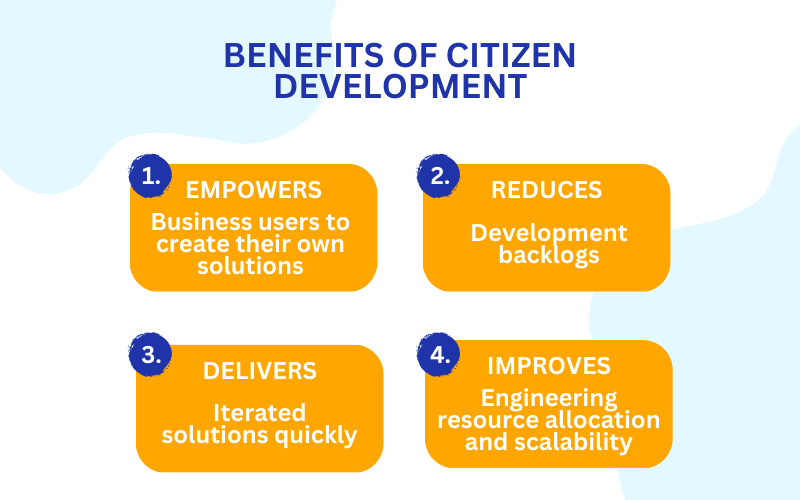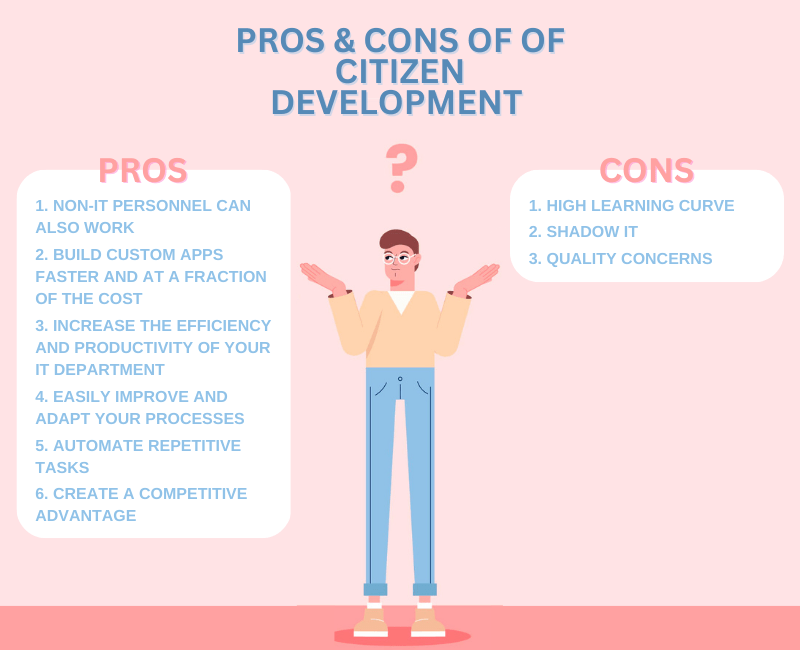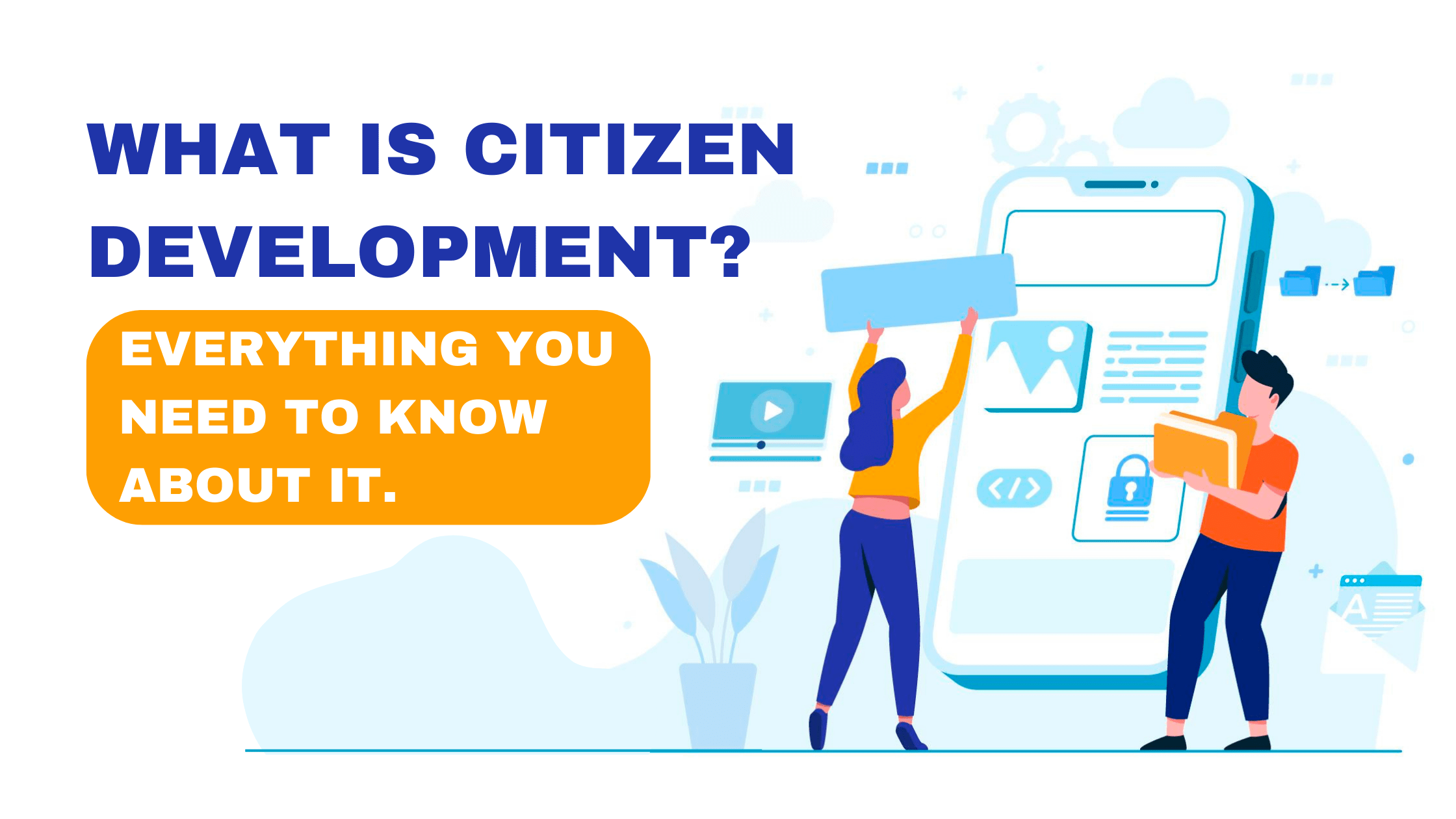If you’re reading this, you probably just googled “citizen developer.”
Perhaps you want to incorporate citizen development into your organization. Maybe you’re just curious about the subject.
With companies constantly undergoing digital transformation, IT teams are under intense pressure, resulting in IT backlogs. This is where citizen development can help.
Citizen-led development has been adopted by businesses all over the world because it provides non-IT experts with the necessary technology and IT support to create the basic apps they require. Employees who create their own apps work more efficiently, reduce the company’s operating costs, and reduce the IT backlog.
We’ll cover everything you need to know about citizen development in this guide, including a simple definition, pros and cons, examples, and necessary technology.
Let’s start with the basics.
WHAT IS CITIZEN DEVELOPMENT?
Citizen development is defined as the process by which non-IT-trained employees become software developers by building business-critical applications using low-code/no-code (LCNC) platforms. It can be also put as IT-sanctioned and approved applications created through citizen development methods.
This distinguishes the concept of citizen development from shadow IT. Citizen developers are non-IT experts who seek solutions to their specific problems and use low-code/no-code platforms to create them.

Any non-developer (regular user) who can use no-code platforms to build a specific business app is referred to as a citizen developer.
No-code application development is not a new practice; in fact, most major SaaS platforms have been using this model for quite some time. But it has certainly grown in popularity in recent years.
According to Gartner, no-code or low-code platforms are used to create technology solutions by 4 out of 10 non-IT employees on average. According to the same study, the global no-code market will be worth $13.8 billion in 2021, a 22.6% increase over last year.
As digital agility improves, more employees are becoming citizen developers, developing applications on their own. Citizen developers can be found in departments such as human resources, research and development, finance, and customer service.
WHAT ARE NO-CODE DEVELOPMENT PLATFORMS?
No-code development is the process of creating software using visual models rather than code.
Rather than writing lines of code, you simply drag and drop various elements.
This is made possible by a concept known as “abstraction.”
Abstraction takes away the complex nature of writing code from scratch and replaces it with pre-built “code snippets” that you can use to build the app solution you desire.
No-code development provides a user-friendly interface to select and place options, themes, and menus of apps without writing even a single line of coding. The app can be viewed on The Preview screen, and you can edit your app visually quite easily.
WHAT DOES A CITIZEN DEVELOPER DO?
With the help of IT, citizen developers create applications to solve business problems. They use no-code and low-code app development tools to create new business applications for themselves and other employees to use. They have a thorough understanding of an organization’s or department’s processes, as well as advanced digital skills. This enables them to easily create efficient business apps and automate workflows using citizen automation.
Source: Gartner
Citizen developers are distinct from professional developers who build solutions with pro code. Pro code platforms rely solely on code, whereas no-code systems employ a graphical user interface that enables users to create apps without coding.
THE PROS AND CONS OF CITIZEN DEVELOPMENT
Citizen development is a powerful concept that has the potential to transform your business for the better.
However, it is not without flaws.
So, now that you understand the fundamentals of this model, let’s look at some of the advantages and disadvantages of the process.

PROS of Citizen Development
Some of the primary advantages of citizen development include:
Non-IT personnel can also work: This helps to bring more creative ideas to the table, reduces the workload of the IT department, and thus increases productivity.
Build custom apps faster and at a fraction of the cost: citizen developers can create a new application in days, not months, which can drastically reduce your development costs.
Increase the efficiency and productivity of your IT department: No-code platforms, when properly implemented, can improve collaboration between IT professionals and non-devs.
Easily improve and adapt your processes: no-code technology enables anyone in your organisation to identify opportunities for improvement and build a solution on their own.
Automate repetitive tasks: artificial intelligence helps you in automating repetitive processes and reuse that time into more productive initiatives, which goes hand in hand with citizen development.
Create a competitive advantage: quickly adapting to constantly changing situations can become a true business advantage.
CONS of Citizen Development
Some of the disadvantages of citizen development include:
High Learning curve: While citizen development is simpler than traditional development, you must train your employees on how to use no-code development platforms.
Shadow IT: Because almost anyone can create a custom app, your IT department may lose control of some development processes.
Quality concerns: developing so many new business applications in such a short period of time can result in low-quality development.
The good news is that all of these issues can be easily avoided by following the proper procedures.
WHY DO YOU NEED CITIZEN DEVELOPMENT IN AN ORGANIZATION?
Most organizations’ IT departments have such a large backlog of work that they are unable to respond to new requests quickly. They are overwhelmed by an endless stream of requests, and keeping up is impossible. This is where citizen-led development comes into play.
- 71% of business leaders believe that IT teams are ignoring a large number of new solution requests.
- According to 451 Research, integrating low-code/no-code tools can increase development efficiency by 50%-90%.
- 41% of those polled have active citizen development programmes, with another 20% planning to start one.
- The number of citizen developers would be four times that of professional developers by 2023.
- Based on a Gartner report many organizations have active or planned citizen development strategies.
A few key principles underpin citizen development:
- A streamlined app development process: using visual elements to create custom technology solutions.
- Data access: non-developers (non-devs) have access to organizational data, allowing them to design solutions to problems more quickly.
- Process optimization: using workflows and standardization to digitize and optimize business processes.
- Work centralization: the removal of gaps between IT and the rest of the process in order to maximize cooperation and innovate faster, and more frequently.
These principles make it easier for modern organizations to deal with the constantly changing environment.
The concept of a “citizen developer” arose to address this issue and provide all employees with the ability to create their own solutions without the assistance of an IT professional. This does not imply that IT is no longer relevant, but rather the opposite.
Citizen development bridges the gap between IT and your other departments, allowing them to collaborate more quickly, optimize more frequently, and solve problems more efficiently.
PROFESSIONAL DEVELOPER VS. CITIZEN DEVELOPER
| Traditional development | Citizen development | |
| Code | Pro-code | No-code |
| Ease of use | Much difficult for non-tech staff | Anyone can make apps |
| Speed of app launch | Long process | Quick-to-launch apps |
| App Development Cost | $40K to $250K+ | <$10k |
| IT Involvement | High | Minimal |
| Primary Focus | Technology management | Business automation and productivity enhancement |
Citizen development emerged from business analysts’ realizations that professional developers were given far too much responsibility, as they were expected to create applications as well as troubleshoot existing ones. Because these IT professionals had a backlog of queries from various departments, projects would sit in their queue for months.
Rather, LCNC (Low-code/ No-code) platforms now allow employees with no professional development experience – known as citizen developers – to create applications for their co-workers and customers.
Since citizen developers are much more likely to be well-versed in their area of expertise than professional developers, applications created and updated by citizen developers — closely supervised by professional IT developers — are much more likely to cater to the needs of users who are either part of the citizen development community or benefit from their expertise.
Citizen development is here to stay and will play an increasingly important role in application development. Businesses today must strike a balance between the speed and suitability of citizen developers’ targeted creations and the security and oversight provided by professional developers.
WHAT SKILLS ARE REQUIRED FOR A CITIZEN DEVELOPER?
Here are four essential skills that business users must have in order to build an effective citizen development model:
Complete understanding of business operations:
To create effective business apps, a citizen developer must be well-versed in various business processes, as well as their inefficiencies and bottlenecks. This will assist them in analyzing and developing the appropriate processes and apps that are aligned with their organization’s goals.
Enhanced digital skills:
To ensure a long-term citizen development framework, a thorough understanding of business processes should be combined with advanced digital skills. Process analytics, document creation, and no-code bot automation are all examples of skills required.
Capability to collaborate across departments:
One of the primary goals of low-code and no-code platforms is to maximize citizen developers across departments. In such a case, a citizen developer must serve as a bridge, ensuring flawless cooperation between business and IT in order to achieve organizational goals as a whole.
Motivated to learn new skills:
The concept of citizen development has recently gained traction, making way for the digital revolution. In that case, motivation to upskill is critical, and business users must be willing to invest time to self-educate and master the no-code skills.
WHAT DO YOU NEED TO BE A SUCCESSFUL CITIZEN DEVELOPER?
You must understand a few key concepts to get the most out of citizen development.
Let’s analyse them.
1. Recognize the importance of software in today’s organizations.
Whether you’re a marketing agency, an eCommerce company, or a SaaS provider, the software is a critical component of your business.
The majority of your operations are carried out in and through software.
You’ll eventually reach a breaking point if you don’t have a quick and dependable way to manage, optimize, and improve all of the software processes involved in your business.
The first thing you should understand is that citizen development is no longer a luxury for modern organizations, but rather a necessity.
2. Use the appropriate no-code development platform.
Many platforms assert to be no-code when in fact they are not.
You can certainly move some elements around by dragging and dropping them, but that’s pretty much it. To get the most out of citizen development, look for a platform that completely immerses you in a no-code experience.
So, how does a real-world no-code platform look?
As an example, consider Swing2App.



WHY IS SWING2APP THE BEST NO-CODE TOOL FOR CITIZEN DEVELOPERS?
Most companies’ IT departments are overburdened. They have a massive backlog, and new requests for solutions never seem to stop coming in. That is why it is critical to empower citizen developers. They claim to have a solution for both budget and staffing issues, and all they need is a good no-code platform.
Swing2App’s citizen development platform is a simple work platform that will help you become a citizen developer quickly. It does not require extensive restructuring to use and contains a plethora of excellent tools that are simple to grasp. Sign up for a free trial today to get started building apps on a budget.
